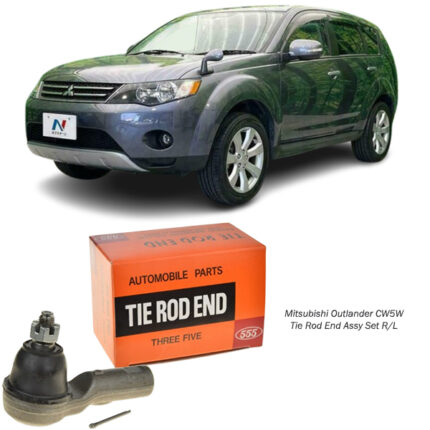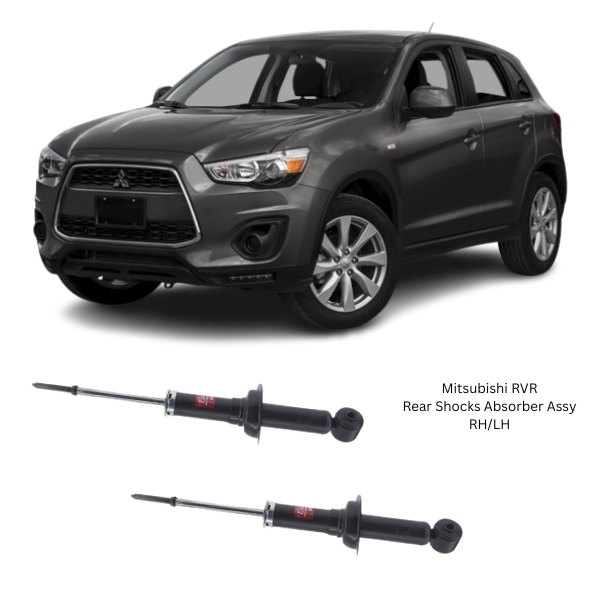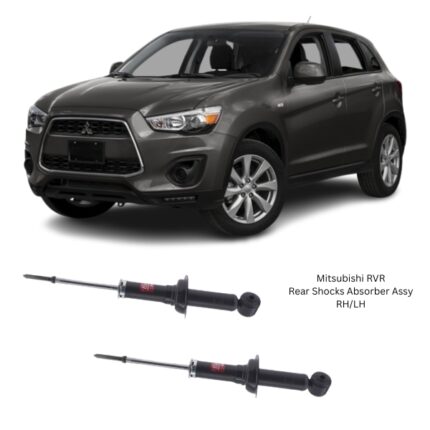Get Mitsubishi RVR Rear Shocks Absorber Assy RH/LH 340060 in Kenya
The Rear Shock Absorber Assembly RH/LH is an essential component of a vehicle’s suspension system, designed to control rear wheel movement, enhance ride comfort, and ensure overall vehicle stability. Installed on both the right-hand (RH) and left-hand (LH) sides of the rear axle, these shock absorbers play a vital role in damping the up-and-down motion caused by road irregularities and load transfers, especially when accelerating, braking, or driving over uneven terrain.
Shock absorbers function by converting kinetic energy from suspension movement into thermal energy, which is then dissipated through hydraulic fluid or gas pressure within the unit. This process prevents excessive oscillation of the springs and ensures that the tires remain in contact with the road surface at all times, which is crucial for safe and controlled driving.
Construction and Engineering
A Rear Shock Absorber Assembly RH/LH is engineered to withstand repeated stress, temperature changes, and harsh road conditions. The construction typically includes:
-
Outer Cylinder (Shock Body): A strong metal casing, usually made of steel or aluminum, that houses the internal components and provides structural integrity.
-
Piston and Rod Assembly: The piston, attached to a chrome-plated rod, moves up and down within the cylinder and controls fluid flow through small valves to generate damping resistance.
-
Hydraulic Fluid or Gas Chamber: The interior of the shock is filled with hydraulic oil or a combination of oil and pressurized nitrogen gas to manage energy dissipation.
-
Valving System: Located within the piston and base of the cylinder, it regulates fluid flow to deliver controlled resistance during compression and rebound.
-
Dust Boot or Shield: Protects the piston rod from contaminants like dirt, water, and debris, preserving seal integrity and minimizing wear.
-
Mounting Bushings and Eyelets: Designed to absorb vibrations and connect the shock securely to the chassis and suspension arm.
-
Bump Stop: Prevents metal-to-metal contact in case of full compression, helping to cushion impacts.
Modern rear shocks may be mono-tube or twin-tube in design. Mono-tube shocks offer superior heat dissipation and performance under high-load conditions, while twin-tube shocks provide balanced damping for everyday driving.
Functional Purpose
The Rear Shock Absorber Assembly performs several critical roles in the rear suspension system:
-
Controls Suspension Movement: It regulates how quickly the rear suspension compresses and rebounds after hitting bumps or dips.
-
Minimizes Vehicle Bounce: Helps stabilize the rear end after load shifts or impacts, reducing oscillations.
-
Maintains Tire Contact: Ensures that rear tires remain in consistent contact with the ground, improving traction and braking.
-
Improves Load Handling: Assists in managing rear load transfer during acceleration and towing conditions.
-
Enhances Ride Comfort: Smoothens out vibrations and roughness for rear-seat passengers, improving the overall ride experience.
-
Reduces Body Roll and Sway: Works with the suspension system to improve vehicle stability during cornering or lane changes.
By ensuring that rear wheel movement remains controlled and predictable, the shock absorber contributes significantly to overall safety, ride quality, and vehicle handling.
Advantages of a High-Quality Rear Shock Absorber Assembly
Upgrading or replacing worn shocks with high-quality rear shock absorber assemblies offers multiple performance and safety benefits:
-
Enhanced Ride Comfort: Absorbs vibrations, potholes, and road undulations to deliver a smoother drive.
-
Improved Handling and Stability: Reduces sway and bounce during high-speed maneuvers, braking, or cornering.
-
Tire Protection: Minimizes cupping and uneven wear by keeping the rear wheels planted.
-
Increased Suspension Longevity: Reduces stress on springs, control arms, and bushings.
-
Noise and Vibration Reduction: Quality bushings and fluid dynamics help eliminate harshness and rattles.
-
Better Load Management: Supports rear vehicle balance under heavy loads or when towing.
These benefits make rear shocks a critical focus area in both performance upgrades and routine vehicle maintenance.
Signs of Worn or Failing Rear Shock Absorbers
Due to constant motion and exposure to the elements, rear shocks degrade over time. Signs of wear include:
-
Bouncing or Bottoming Out: Excessive rear bounce after hitting a bump, or the suspension bottoming out on dips.
-
Rear-End Sag: Unusual lowering of the rear end, especially under load.
-
Longer Stopping Distances: Poor tire contact with the road can result in less effective braking.
-
Uneven or Rapid Tire Wear: Cupping or scalloping on rear tires due to inconsistent wheel damping.
-
Leaking Fluid: Oil seeping from the shock body is a clear indication of internal seal failure.
-
Nose-Diving or Swaying: Noticeable vehicle pitch or instability during braking and turns.
-
Clunking or Rattling Noises: Caused by loose mounts, worn bushings, or broken internal components.
If any of these symptoms are observed, timely replacement is necessary to restore proper suspension performance.
Installation and Replacement Process
Replacing the Rear Shock Absorber Assembly RH or LH involves several key steps:
-
Lift and Support the Vehicle: Secure the rear of the vehicle using jack stands to relieve load on the suspension.
-
Remove the Rear Wheel (if necessary): Provides access to the upper and lower shock mounting points.
-
Disconnect the Old Shock Absorber: Unbolt the upper and lower mounting hardware, ensuring the suspension is slightly compressed.
-
Inspect Mounting Points and Bushings: Check for corrosion, cracks, or wear that could affect installation or performance.
-
Install the New Assembly: Position the shock absorber and torque the mounting bolts according to specifications.
-
Repeat on Opposite Side: Always replace rear shocks in pairs to ensure balanced damping and safety.
-
Test Drive the Vehicle: Evaluate the rear suspension for noise, bounce, and improved stability.
Professional installation ensures that torque values and fitment standards are met, especially for vehicles with advanced suspension systems.
Maintenance and Inspection
Although rear shocks are generally maintenance-free, periodic inspection is key to ensuring long-term performance:
-
Visual Inspections: Look for signs of leaks, damage, or excessive wear during routine servicing.
-
Check Dust Boots: Ensure boots are intact to prevent contamination and rod scoring.
-
Monitor Tire Wear and Handling: Sudden changes may indicate internal shock issues.
-
Avoid Overloading: Stay within manufacturer-specified load limits to prevent premature shock wear.
-
Clean Regularly: Remove accumulated dirt or road salt to extend the life of the component.
Routine care enhances shock performance and ensures consistent driving quality.
Compatibility and Fitment
Proper fitment of the Rear Shock Absorber Assembly RH/LH is essential for optimal suspension operation. The assembly must match the vehicle’s specifications in terms of:
-
Length and compression range
-
Mounting configuration
-
Damping force calibration
-
Load handling capability
Using the correct part ensures secure installation, proper wheel alignment, and uninterrupted suspension movement. Only assemblies that meet or exceed OEM standards should be used for replacements.
Follow us on Facebook for more parts.




